Rob's Tip of the Month
The Dos and Don'ts of Amateur Radio!
Rob L. Dey, KA2BEO
Try this...
Don't try this...
Try this idea for yourself!
This section is devoted monthly to helpful hints for improving the exciting hobby of Ham Radio.
1997 to 1998


JANUARY 1998
 A pound of salt is cheap! Next time you need to install a ground rod for your station,
try pouring some salt in and around the hole to decrease ground losses.
If possible, avoid using the "iodized" type of salt.
A pound of salt is cheap! Next time you need to install a ground rod for your station,
try pouring some salt in and around the hole to decrease ground losses.
If possible, avoid using the "iodized" type of salt.
DECEMBER 1997
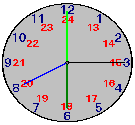 Consider adding another hour-hand to an existing 12-hour clock for the Coordinated Universal Time zone (UTC/GMT/Zulu).
This simple modification allows the clock to display UTC and local time simultaneously.
Also, try adding 24-hour labels to a standard clock face as shown here.
Consider adding another hour-hand to an existing 12-hour clock for the Coordinated Universal Time zone (UTC/GMT/Zulu).
This simple modification allows the clock to display UTC and local time simultaneously.
Also, try adding 24-hour labels to a standard clock face as shown here.
NOVEMBER 1997
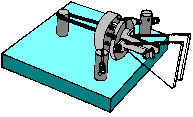 Hold down keys and keyer paddles securely to your favorite operating position, using any one of
these "time-proven" methods.
Hold down keys and keyer paddles securely to your favorite operating position, using any one of
these "time-proven" methods.
OCTOBER 1997
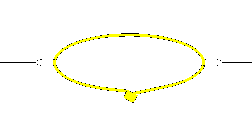 Try using plastic cable ties (also called wire ties, wire wraps, or capacitor ties) as center and end
"egg" insulators when constructing small wire dipoles for the 10-meter through UHF bands.
The smaller (less than 2" diameter) plastic ties are typically rated to withstand at least an 18-pound tensile load when formed into a loop.
Some of these smaller plastic ties are rated up to 50-pounds.
Many 2" diameter and larger ties can withstand even larger loads, up to 250-pounds.
Try using plastic cable ties (also called wire ties, wire wraps, or capacitor ties) as center and end
"egg" insulators when constructing small wire dipoles for the 10-meter through UHF bands.
The smaller (less than 2" diameter) plastic ties are typically rated to withstand at least an 18-pound tensile load when formed into a loop.
Some of these smaller plastic ties are rated up to 50-pounds.
Many 2" diameter and larger ties can withstand even larger loads, up to 250-pounds.
SEPTEMBER 1997
 Whether you operate contests or not, try using a foot switch for your rig's push-to-talk (PTT) control during voice transmissions.
A foot switch can be obtained at your local RadioShack for only $3.99, part number 44-610.
Ever since I started using one on HF, I can't stop. For Field Day, it's great having both hands free for logging contacts at the keyboard.
It makes handling 807s (beer bottles) a lot easier too!
Whether you operate contests or not, try using a foot switch for your rig's push-to-talk (PTT) control during voice transmissions.
A foot switch can be obtained at your local RadioShack for only $3.99, part number 44-610.
Ever since I started using one on HF, I can't stop. For Field Day, it's great having both hands free for logging contacts at the keyboard.
It makes handling 807s (beer bottles) a lot easier too!
AUGUST 1997
 For your next Field Day or emergency communications, you can build a simple 12Vdc @ 60A portable gas generator with a 5hp lawn-mower engine and a car alternator.
I designed, built, and used this one for Field Day '95. It's been in use for three consecutive years now!
Plans for this generator may be published on my Web site in the near future with enough requests. I'll include a parts list,
necessary wiring information, and important tips, like adding a flywheel to prevent "backfiring" for safe starting.
If you can't wait that long, a construction article appeared recently in QST, June 1997, pages 45 to 48.
It's a little more complicated than necessary, but should work okay.
For your next Field Day or emergency communications, you can build a simple 12Vdc @ 60A portable gas generator with a 5hp lawn-mower engine and a car alternator.
I designed, built, and used this one for Field Day '95. It's been in use for three consecutive years now!
Plans for this generator may be published on my Web site in the near future with enough requests. I'll include a parts list,
necessary wiring information, and important tips, like adding a flywheel to prevent "backfiring" for safe starting.
If you can't wait that long, a construction article appeared recently in QST, June 1997, pages 45 to 48.
It's a little more complicated than necessary, but should work okay.
JULY 1997
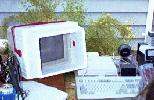 A foam cooler can be used to shade your computer monitor during outdoor use.
Simply cut off the bottom.
You can paint the inside walls of the cooler black to reduce glare.
Also, be careful when selecting the paint, some paints melt styrofoam.
I used this one for Field Day '97.
A foam cooler can be used to shade your computer monitor during outdoor use.
Simply cut off the bottom.
You can paint the inside walls of the cooler black to reduce glare.
Also, be careful when selecting the paint, some paints melt styrofoam.
I used this one for Field Day '97.
Do not try this at home!
This section is devoted monthly to things learned the hard way, by trial and error, throughout the exciting hobby of Ham Radio.
1997 to 1998


JANUARY 1998
 Considering the use of salt to improve ground conductivity for your ground rod?
Don't grab the sugar by mistake. It's more expensive, and will attract lots of insects!
Considering the use of salt to improve ground conductivity for your ground rod?
Don't grab the sugar by mistake. It's more expensive, and will attract lots of insects!
DECEMBER 1997
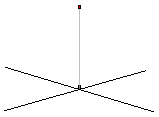 Have you ever tried using a vertical antenna without ground radials?
I've found (as suspected) that it performs pretty poorly.
Four to 15 radials are the minimum that should be used.
Also, remember that many short radials are better than a few long ones.
Have you ever tried using a vertical antenna without ground radials?
I've found (as suspected) that it performs pretty poorly.
Four to 15 radials are the minimum that should be used.
Also, remember that many short radials are better than a few long ones.
NOVEMBER 1997
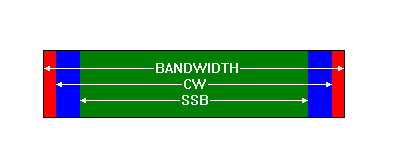 As a friendly reminder and general rule-of-thumb to stay within the band limits,
avoid transmitting less than 1kHz from the band edge on CW.
On SSB, 3kHz is the general rule-of-thumb.
As a friendly reminder and general rule-of-thumb to stay within the band limits,
avoid transmitting less than 1kHz from the band edge on CW.
On SSB, 3kHz is the general rule-of-thumb.
OCTOBER 1997
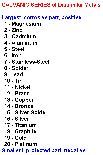 When building antennas and other outdoor structures, pay close attention to the types of metals used and which materials
come in contact with each other. When possible, avoid joining dissimilar metals.
For long outdoor life, mating metals should be similar materials to reduce any Galvanic
effects, which cause corrosion.
For example, avoid connecting copper wire directly to aluminum tubing.
Instead, use an intermediate metal between the two different metals, such as
stainless-steel washers, or a tinned solder lug, with a stainless-steel machine screw.
Use the table provided to select and join only metals that are positioned close to each other in the list.
This will minimize Galvanic voltages, and reduce corrosion.
Another approach is to choose an intermediate metal that reverses the polarity of one potenial
(ie.: using cadmium-plated steel hardware on aluminum tubing).
When building antennas and other outdoor structures, pay close attention to the types of metals used and which materials
come in contact with each other. When possible, avoid joining dissimilar metals.
For long outdoor life, mating metals should be similar materials to reduce any Galvanic
effects, which cause corrosion.
For example, avoid connecting copper wire directly to aluminum tubing.
Instead, use an intermediate metal between the two different metals, such as
stainless-steel washers, or a tinned solder lug, with a stainless-steel machine screw.
Use the table provided to select and join only metals that are positioned close to each other in the list.
This will minimize Galvanic voltages, and reduce corrosion.
Another approach is to choose an intermediate metal that reverses the polarity of one potenial
(ie.: using cadmium-plated steel hardware on aluminum tubing).
SEPTEMBER 1997
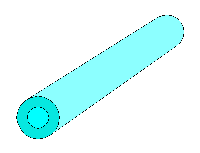 A source for plastic Spaghetti tubing?
Since the early 1970's (at least), several Amateur Radio publications recommended obtaining "used" Spaghetti tubing from hospitals (bio-hazardous medical waste) to use in electronics applications.
This is no longer a recommended practice for obvious reasons.
I'm not even sure if this is legal in most places.
A simple alternative is to use insulation stripped from ordinary hook-up wire that you probably already have lying around the shack.
A source for plastic Spaghetti tubing?
Since the early 1970's (at least), several Amateur Radio publications recommended obtaining "used" Spaghetti tubing from hospitals (bio-hazardous medical waste) to use in electronics applications.
This is no longer a recommended practice for obvious reasons.
I'm not even sure if this is legal in most places.
A simple alternative is to use insulation stripped from ordinary hook-up wire that you probably already have lying around the shack.
AUGUST 1997
 If possible, avoid using white light bulbs during Field Day.
Instead, use yellow "Bug" light bulbs to create a more operator-friendly radio station during the night.
Although the 60-watt yellow lamps provide 550 lumens of light output versus the typical 800 lumens of white lamps, the "Bug" lights give a cozy glow to Field Day night-time operations. Yet, the yellow lamps offer plenty of light for logging, control setting, and other tasks throughout the evening.
I found that only tiny (non-biting) flying insects seem to be attracted to this somewhat monochromatic light.
If on Field Day you don't use commercial mains or an ac generator for lighting, try covering your flashlights and portable lanterns with
Reynolds®
yellow-tinted plastic food wrap that's available at most local food stores.
For 12Vdc lighting, try using a solid-state "Bug" lamp made from an array of yellow LEDs.
My last Field Day was much more pleasant at night with the use of yellow lamps. I hope your future Field Day evenings will be "swatless" too.
If possible, avoid using white light bulbs during Field Day.
Instead, use yellow "Bug" light bulbs to create a more operator-friendly radio station during the night.
Although the 60-watt yellow lamps provide 550 lumens of light output versus the typical 800 lumens of white lamps, the "Bug" lights give a cozy glow to Field Day night-time operations. Yet, the yellow lamps offer plenty of light for logging, control setting, and other tasks throughout the evening.
I found that only tiny (non-biting) flying insects seem to be attracted to this somewhat monochromatic light.
If on Field Day you don't use commercial mains or an ac generator for lighting, try covering your flashlights and portable lanterns with
Reynolds®
yellow-tinted plastic food wrap that's available at most local food stores.
For 12Vdc lighting, try using a solid-state "Bug" lamp made from an array of yellow LEDs.
My last Field Day was much more pleasant at night with the use of yellow lamps. I hope your future Field Day evenings will be "swatless" too.
JULY 1997
 The idea of a 70cm (440MHz) or 2m (144MHz) vertical dipole made from alarm tape on a window sounds better than it actually works.
The SWR was practically (or impractically) infinite. I suspect the main reason for the high SWR was that the good mechanical connections made poor RF conductors at VHF and UHF.
The idea of a 70cm (440MHz) or 2m (144MHz) vertical dipole made from alarm tape on a window sounds better than it actually works.
The SWR was practically (or impractically) infinite. I suspect the main reason for the high SWR was that the good mechanical connections made poor RF conductors at VHF and UHF.




 A pound of salt is cheap! Next time you need to install a ground rod for your station,
try pouring some salt in and around the hole to decrease ground losses.
If possible, avoid using the "iodized" type of salt.
A pound of salt is cheap! Next time you need to install a ground rod for your station,
try pouring some salt in and around the hole to decrease ground losses.
If possible, avoid using the "iodized" type of salt. Consider adding another hour-hand to an existing 12-hour clock for the Coordinated Universal Time zone (UTC/GMT/Zulu).
This simple modification allows the clock to display UTC and local time simultaneously.
Also, try adding 24-hour labels to a standard clock face as shown here.
Consider adding another hour-hand to an existing 12-hour clock for the Coordinated Universal Time zone (UTC/GMT/Zulu).
This simple modification allows the clock to display UTC and local time simultaneously.
Also, try adding 24-hour labels to a standard clock face as shown here. Hold down keys and keyer paddles securely to your favorite operating position, using any one of
these "time-proven" methods.
Hold down keys and keyer paddles securely to your favorite operating position, using any one of
these "time-proven" methods.
 Try using plastic cable ties (also called wire ties, wire wraps, or capacitor ties) as center and end
"egg" insulators when constructing small wire dipoles for the 10-meter through UHF bands.
The smaller (less than 2" diameter) plastic ties are typically rated to withstand at least an 18-pound tensile load when formed into a loop.
Some of these smaller plastic ties are rated up to 50-pounds.
Many 2" diameter and larger ties can withstand even larger loads, up to 250-pounds.
Try using plastic cable ties (also called wire ties, wire wraps, or capacitor ties) as center and end
"egg" insulators when constructing small wire dipoles for the 10-meter through UHF bands.
The smaller (less than 2" diameter) plastic ties are typically rated to withstand at least an 18-pound tensile load when formed into a loop.
Some of these smaller plastic ties are rated up to 50-pounds.
Many 2" diameter and larger ties can withstand even larger loads, up to 250-pounds. Whether you operate contests or not, try using a foot switch for your rig's push-to-talk (PTT) control during voice transmissions.
A foot switch can be obtained at your local RadioShack for only $3.99, part number 44-610.
Ever since I started using one on HF, I can't stop. For Field Day, it's great having both hands free for logging contacts at the keyboard.
It makes handling 807s (beer bottles) a lot easier too!
Whether you operate contests or not, try using a foot switch for your rig's push-to-talk (PTT) control during voice transmissions.
A foot switch can be obtained at your local RadioShack for only $3.99, part number 44-610.
Ever since I started using one on HF, I can't stop. For Field Day, it's great having both hands free for logging contacts at the keyboard.
It makes handling 807s (beer bottles) a lot easier too! For your next Field Day or emergency communications, you can build a simple 12Vdc @ 60A portable gas generator with a 5hp lawn-mower engine and a car alternator.
I designed, built, and used this one for Field Day '95. It's been in use for three consecutive years now!
Plans for this generator may be published on my Web site in the near future with enough requests. I'll include a parts list,
necessary wiring information, and important tips, like adding a flywheel to prevent "backfiring" for safe starting.
If you can't wait that long, a construction article appeared recently in QST, June 1997, pages 45 to 48.
It's a little more complicated than necessary, but should work okay.
For your next Field Day or emergency communications, you can build a simple 12Vdc @ 60A portable gas generator with a 5hp lawn-mower engine and a car alternator.
I designed, built, and used this one for Field Day '95. It's been in use for three consecutive years now!
Plans for this generator may be published on my Web site in the near future with enough requests. I'll include a parts list,
necessary wiring information, and important tips, like adding a flywheel to prevent "backfiring" for safe starting.
If you can't wait that long, a construction article appeared recently in QST, June 1997, pages 45 to 48.
It's a little more complicated than necessary, but should work okay. A foam cooler can be used to shade your computer monitor during outdoor use.
Simply cut off the bottom.
You can paint the inside walls of the cooler black to reduce glare.
Also, be careful when selecting the paint, some paints melt styrofoam.
I used this one for Field Day '97.
A foam cooler can be used to shade your computer monitor during outdoor use.
Simply cut off the bottom.
You can paint the inside walls of the cooler black to reduce glare.
Also, be careful when selecting the paint, some paints melt styrofoam.
I used this one for Field Day '97.

 Considering the use of salt to improve ground conductivity for your ground rod?
Don't grab the sugar by mistake. It's more expensive, and will attract lots of insects!
Considering the use of salt to improve ground conductivity for your ground rod?
Don't grab the sugar by mistake. It's more expensive, and will attract lots of insects! Have you ever tried using a vertical antenna without ground radials?
I've found (as suspected) that it performs pretty poorly.
Four to 15 radials are the minimum that should be used.
Also, remember that many short radials are better than a few long ones.
Have you ever tried using a vertical antenna without ground radials?
I've found (as suspected) that it performs pretty poorly.
Four to 15 radials are the minimum that should be used.
Also, remember that many short radials are better than a few long ones. As a friendly reminder and general rule-of-thumb to stay within the band limits,
avoid transmitting less than 1kHz from the band edge on CW.
On SSB, 3kHz is the general rule-of-thumb.
As a friendly reminder and general rule-of-thumb to stay within the band limits,
avoid transmitting less than 1kHz from the band edge on CW.
On SSB, 3kHz is the general rule-of-thumb. When building antennas and other outdoor structures, pay close attention to the types of metals used and which materials
come in contact with each other. When possible, avoid joining dissimilar metals.
For long outdoor life, mating metals should be similar materials to reduce any Galvanic
effects, which cause corrosion.
For example, avoid connecting copper wire directly to aluminum tubing.
Instead, use an intermediate metal between the two different metals, such as
stainless-steel washers, or a tinned solder lug, with a stainless-steel machine screw.
Use the table provided to select and join only metals that are positioned close to each other in the list.
This will minimize Galvanic voltages, and reduce corrosion.
Another approach is to choose an intermediate metal that reverses the polarity of one potenial
(ie.: using cadmium-plated steel hardware on aluminum tubing).
When building antennas and other outdoor structures, pay close attention to the types of metals used and which materials
come in contact with each other. When possible, avoid joining dissimilar metals.
For long outdoor life, mating metals should be similar materials to reduce any Galvanic
effects, which cause corrosion.
For example, avoid connecting copper wire directly to aluminum tubing.
Instead, use an intermediate metal between the two different metals, such as
stainless-steel washers, or a tinned solder lug, with a stainless-steel machine screw.
Use the table provided to select and join only metals that are positioned close to each other in the list.
This will minimize Galvanic voltages, and reduce corrosion.
Another approach is to choose an intermediate metal that reverses the polarity of one potenial
(ie.: using cadmium-plated steel hardware on aluminum tubing). A source for plastic Spaghetti tubing?
Since the early 1970's (at least), several Amateur Radio publications recommended obtaining "used" Spaghetti tubing from hospitals (bio-hazardous medical waste) to use in electronics applications.
This is no longer a recommended practice for obvious reasons.
I'm not even sure if this is legal in most places.
A simple alternative is to use insulation stripped from ordinary hook-up wire that you probably already have lying around the shack.
A source for plastic Spaghetti tubing?
Since the early 1970's (at least), several Amateur Radio publications recommended obtaining "used" Spaghetti tubing from hospitals (bio-hazardous medical waste) to use in electronics applications.
This is no longer a recommended practice for obvious reasons.
I'm not even sure if this is legal in most places.
A simple alternative is to use insulation stripped from ordinary hook-up wire that you probably already have lying around the shack. If possible, avoid using white light bulbs during Field Day.
Instead, use yellow "Bug" light bulbs to create a more operator-friendly radio station during the night.
Although the 60-watt yellow lamps provide 550 lumens of light output versus the typical 800 lumens of white lamps, the "Bug" lights give a cozy glow to Field Day night-time operations. Yet, the yellow lamps offer plenty of light for logging, control setting, and other tasks throughout the evening.
I found that only tiny (non-biting) flying insects seem to be attracted to this somewhat monochromatic light.
If on Field Day you don't use commercial mains or an ac generator for lighting, try covering your flashlights and portable lanterns with
Reynolds®
yellow-tinted plastic food wrap that's available at most local food stores.
For 12Vdc lighting, try using a solid-state "Bug" lamp made from an array of yellow LEDs.
My last Field Day was much more pleasant at night with the use of yellow lamps. I hope your future Field Day evenings will be "swatless" too.
If possible, avoid using white light bulbs during Field Day.
Instead, use yellow "Bug" light bulbs to create a more operator-friendly radio station during the night.
Although the 60-watt yellow lamps provide 550 lumens of light output versus the typical 800 lumens of white lamps, the "Bug" lights give a cozy glow to Field Day night-time operations. Yet, the yellow lamps offer plenty of light for logging, control setting, and other tasks throughout the evening.
I found that only tiny (non-biting) flying insects seem to be attracted to this somewhat monochromatic light.
If on Field Day you don't use commercial mains or an ac generator for lighting, try covering your flashlights and portable lanterns with
Reynolds®
yellow-tinted plastic food wrap that's available at most local food stores.
For 12Vdc lighting, try using a solid-state "Bug" lamp made from an array of yellow LEDs.
My last Field Day was much more pleasant at night with the use of yellow lamps. I hope your future Field Day evenings will be "swatless" too. The idea of a 70cm (440MHz) or 2m (144MHz) vertical dipole made from alarm tape on a window sounds better than it actually works.
The SWR was practically (or impractically) infinite. I suspect the main reason for the high SWR was that the good mechanical connections made poor RF conductors at VHF and UHF.
The idea of a 70cm (440MHz) or 2m (144MHz) vertical dipole made from alarm tape on a window sounds better than it actually works.
The SWR was practically (or impractically) infinite. I suspect the main reason for the high SWR was that the good mechanical connections made poor RF conductors at VHF and UHF.